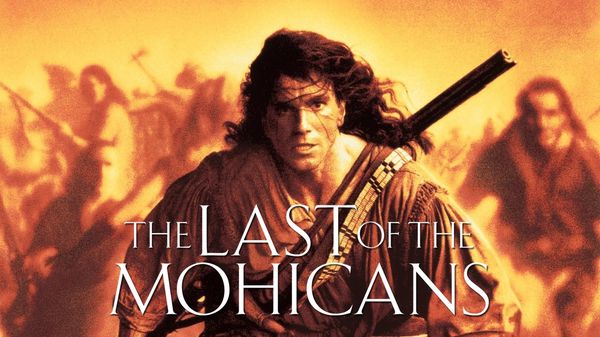The Last of the Mohicans (1992)

Michael Mann’s 1992 film The Last of the Mohicans is a masterful adaptation of James Fenimore Cooper’s classic novel, set against the backdrop of the French and Indian War. Renowned for its breathtaking cinematography, intense performances, and stirring score, the film is a poignant exploration of love, conflict, and survival in a tumultuous period of American history. With its rich historical context and vivid portrayal of the struggle between indigenous peoples and European settlers, the film stands as a significant work in American cinema.
The Last of the Mohicans is set during the French and Indian War (1754-1763), a conflict between the British and French empires in North America, and their respective indigenous allies. The film follows the story of Hawkeye, a white man raised by the Mohican tribe, portrayed by Daniel Day-Lewis, and his adopted family, including Chingachgook (Russell Means) and Uncas (Eric Schweig). The narrative centers on their involvement in the rescue of two sisters, Cora (Madeleine Stowe) and Alice Munro (Jodhi May), who are caught in the crossfire of the war.
The film’s plot intertwines personal and political conflict, depicting the brutal realities of colonial warfare and the impact on the lives of the individuals caught in the conflict. Hawkeye, a man torn between his loyalty to the Mohicans and his affection for the Munro sisters, represents the complexities of identity and allegiance during this period. The tension between the British, French, and various Native American tribes forms the backdrop against which the characters’ personal stories unfold.

The character of Hawkeye, portrayed by Daniel Day-Lewis, is central to the film’s narrative. Day-Lewis’s portrayal is both physically and emotionally compelling, embodying the character’s ruggedness, honor, and internal conflict. His performance is marked by a profound sense of authenticity and intensity, capturing the essence of a man who straddles two worlds—one of European heritage and one of indigenous tradition. Hawkeye’s complex relationship with Cora Munro, played by Madeleine Stowe, forms the emotional core of the film. Their romance, set against the backdrop of war, is depicted with both passion and tenderness, highlighting the personal stakes amidst the broader conflict.
Madeline Stowe’s portrayal of Cora Munro is notable for its strength and depth. Cora is depicted as a woman of considerable intelligence and resilience, and Stowe’s performance captures her character’s determination and vulnerability. The chemistry between Stowe and Day-Lewis adds a layer of emotional depth to the narrative, enhancing the film’s exploration of love and sacrifice.
Russell Means’s portrayal of Chingachgook and Eric Schweig’s depiction of Uncas provide strong performances that add authenticity and gravitas to the film. Their characters, representing the Mohican tribe, are depicted with dignity and complexity, challenging stereotypical portrayals of indigenous peoples. The film’s focus on their relationship with Hawkeye and their struggles against encroaching colonial forces highlights the impact of the conflict on Native American communities.
The film explores several profound themes, including the clash of cultures, the nature of heroism, and the struggle for survival. One of the central themes is the tension between European colonialism and indigenous cultures. The film portrays the devastating impact of European expansion on Native American tribes, highlighting the loss of land, culture, and autonomy experienced by indigenous peoples. The Mohicans, as one of the last surviving tribes, symbolize the broader struggle for survival in the face of overwhelming odds.
Another significant theme is the concept of heroism and sacrifice. The characters in The Last of the Mohicans are depicted as individuals who are willing to make personal sacrifices for the greater good. Hawkeye’s actions, driven by a sense of honor and loyalty, exemplify the film’s exploration of the personal cost of heroism. The sacrifices made by Chingachgook and Uncas further emphasize the theme of loyalty and the enduring bond between individuals fighting for their people and their beliefs.
The film also delves into the theme of identity and belonging. Hawkeye’s dual heritage and his struggle to reconcile his place within both European and indigenous cultures reflect the broader conflict of cultural identity during this period. His journey is one of self-discovery and acceptance, as he navigates the complexities of his own identity amidst the larger conflict.

The cinematography of The Last of the Mohicans, led by director of photography Dante Spinotti, is one of the film’s standout features. The film’s breathtaking landscapes and meticulously crafted action sequences are visually stunning, capturing the rugged beauty of the American frontier. The use of natural light and wide-angle shots enhances the film’s immersive experience, allowing viewers to fully appreciate the grandeur and peril of the setting.
The battle sequences are particularly notable for their realism and intensity. The film’s depiction of combat is raw and unflinching, effectively conveying the chaos and brutality of warfare. The attention to detail in the choreography and special effects adds to the film’s authenticity, making the historical context feel immediate and visceral.

The film’s score, composed by Trevor Jones and Randy Edelman, plays a crucial role in shaping its emotional and dramatic impact. The music combines traditional orchestral elements with indigenous instruments, creating a soundtrack that is both evocative and reflective of the film’s cultural themes. The score enhances the film’s atmosphere, from the epic and sweeping themes during battle scenes to the tender and introspective moments of romance and loss.
The Last of the Mohicans was widely acclaimed by critics and audiences for its powerful performances, stunning visuals, and emotional depth. It received praise for its historical accuracy and the respectful portrayal of Native American cultures. The film’s success at the box office and its recognition at various awards ceremonies underscore its impact and enduring legacy in American cinema.
In conclusion, The Last of the Mohicans is a richly layered and compelling film that stands as a significant achievement in historical and epic cinema. Through its powerful performances, breathtaking visuals, and exploration of profound themes, the film offers a poignant and immersive portrayal of love, conflict, and survival in the American frontier. Michael Mann’s direction, combined with a talented cast and evocative score, ensures that the film remains a memorable and influential work in the cinematic landscape.











